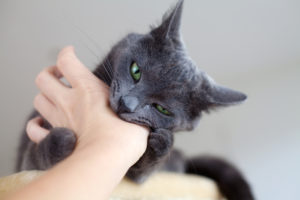Written by: Allison Ward, DVM
If you are like most cat parents, you may not have ever heard that cats can develop arthritis! After all, cats are so flexible and athletic that we normally don’t think of our felines as having much difficulty getting around. However, arthritis in cats is becoming more frequently diagnosed, and more treatment modalities are available to help our furry friends live out their lives in maximum mobility and comfort (LINK to “Guide to Treating Arthritis in Cats”). Cat arthritis symptoms vary greatly from those in dogs, and for any cat-lover, it’s essential to be aware of the warning signs that your cat may be developing this common ailment.
What IS Arthritis, Anyway?
Most of us know that arthritis is a medical condition that causes joint pain, and is more common in humans as we get older. However, did you know that any animal can develop arthritis—including dogs, horses, and even CATS?
Simply put, arthritis is inflammation and abnormal “wear and tear” on joint surfaces. Normal joints allow an animal to bend, flex, run, jump, and even curl up for a much-needed nap. There are several different types of joints in your cat’s body, but we’ll focus on the joints most likely to be affected by arthritis: the stifles (“knees”), hocks (“ankles”), hips, elbows, and carpi (“wrists”). Joints in your cat’s spine (neck and back) can also be affected by arthritis, even though the anatomy of these joints is slightly different than the others we’ll discuss.
Joint Components
For starters, let’s talk about the components of one of these joints. When you bend your knee, you can think of the knee joint as kind of a hinge connecting your thighbone to your shinbone. What’s in the middle of that hinge? A complicated structure consisting of tendons and ligaments—so-called soft tissues that act like cables connecting the parts of your leg and kneecap with each other. The hinge also contains a squishy fluid-filled sac called a bursa that is filled with joint fluid. The bursa acts as a shock absorber to distribute weight from standing, walking, running, and jumping so that the end of your thighbone doesn’t smash into the end of your shinbone! Of course, you also have a kneecap that glides over your knee as you bend and extend your leg—but your kneecap should never move from side-to-side. Spoiler alert: your cat’s knees (and other joints) have the same components!
Changes in Arthritis
When your cat walks, runs, jumps, or starts tearing through the house during their nighttime zoomies, stress is put on their joints. Over time, this stress leads to the microscopic breakdown of the joint surfaces.
If any part of the joint is irritated from instability or too much “wear and tear,” the body sends cells to the joint in an attempt to repair the damage. This can result in inflammation of the joint cartilage, bone surface, bursa, and the lining of the bursa—and starts a never-ending cycle of attempted repair followed by inflammation and even more deterioration of normal tissue. Alas, the body’s attempt at self-repair often results in uneven and irregular surfaces within the joint, which cause even MORE inflammation, followed by MORE breakdown…you get the picture! With inflammation comes chronic PAIN—just like in humans.
Once your cat is painful, he may alter the way he bears weight on one or more limbs—further stressing joint surfaces in ways that are not normal for the way they are designed by nature. This continues to add to the problem. One symptom of cat arthritis includes decreased activity levels, since understandably a cat with aching joints wants to stay off his feet—and this could also lead to weight gain. Weight gain also INCREASES the pressure on your cat’s joints, speeding up the process of arthritis and worsening their pain.
You can see how feline arthritis can become a never-ending cycle once it starts—and imagine how greatly it impacts your cat’s quality of life!
Causes of Arthritis in Cats
So, what causes the joint inflammation that begins the never-ending cycle of arthritis? Most of the time, this inflammation is related to aging itself, and can’t be prevented. (One study found that 90% of cats over the age of 12 have arthritic joint changes on x-rays!) Some cats are born with abnormally-shaped joints (called “dysplasia”) that set them up for the rapid development of arthritis, even from a young age. This type of joint malformation is more common in purebred cats, and is seen in almost ALL of purebred Scottish Fold cats.
Other factors that increase the development and severity of arthritis are more within your control: obesity is a HUGE (pun intended!) risk factor for this condition, since excess weight increases the work your cat’s joints have to perform with every step. Keeping your cat at a healthy weight is good for their overall health as well as the health of their joints! Also, if your cat is unlucky enough to suffer an injury—such as a broken leg or torn ligament—then his body will continue to form scar tissue in that area over time, leading to arthritis in the affected joints.
Other causes of arthritis pain are much, much less common (thank goodness!,) and include infections of the joint (usually from a whole-body infection that goes into the bloodstream to affect the joint), or the immune system getting confused and attacking the joint tissue (this is called immune-mediated arthritis). If your cat has been treated for either of these diseases in the past, then you can expect her to have more severe arthritis and at an earlier age.
Symptoms of Arthritis in Cats
Now that we’ve discussed HOW arthritis happens, let’s talk about why we should care and what you might see as a cat parent! We all know how cats love to hide their discomfort and pretend like everything is okay until they just aren’t able to pretend anymore. As a savvy cat lover, there are some telltale signs your cat is suffering from joint pain and that a vet visit is warranted.
Changes in Jumping Habits
At AskVet, we know that nobody knows your cat better than YOU! Undoubtedly, you know your cat’s favorite places to perch and have marveled at how easily he jumps up to and off of high surfaces—like countertops, windowsills, and the upper levels of his favorite cat tree.
As arthritis begins to develop, your kitty will still enjoy accessing his favorite places up high—but he may arrive at his destination with a layover instead of a direct flight (so to speak!). For example, if your cat has been jumping onto your countertop with ease for years, and is now hopping onto a chair before making a final leap onto the counter, then he is likely suffering some discomfort. If he normally jumps onto his favorite chair without a problem, but starts to hesitate before leaping, this is a sign that he is anticipating something unpleasant at the end of his jump—such as a painful landing due to aching joints.
Alternatively, when jumping down, cats with healthy pain-free joints don’t hesitate to leap after a brief look. Cats with arthritis will instead “pour” down countertops or other high surfaces by bracing one paw against the vertical surface first, and then gently easing themselves over the edge and down to the ground. This maneuver helps decrease the force of the “thump” when they land on the floor, and is commonly seen in cats with arthritis of the front legs (shoulders, elbows, carpi) or neck.
As arthritis progresses, you may notice your cat having difficulty “landing” jumps—instead of that cat-like grace, your cat may be jumping too short and end up scrambling to pull themselves up onto a high surface, or even falling when they try. When your cat tries to get up on the couch, instead of a graceful leap, you might see your cat put his front paws on the couch and try to rock or pull himself up. You may also notice your cat hanging out in their favorite high-up perches less frequently—since they are avoiding pain that comes when jumping—or choosing to spend more of their time in lower-level cat beds and other areas.
Changes in Walking
In general, it is uncommon to see a cat actually limp, or “favor” a leg, from arthritis. Instead, arthritic cats tend to move more slowly overall. You may notice that your cat seems stiff and walks with shorter strides when she first wakes up after a long nap, only to move more freely after a few minutes. If you have stairs in your house, you may notice that your cat is slower to navigate the stairs (either up or down), or she may pull herself up from stair to stair. She may avoid going up or down stairs completely, and instead “ask for help” by meowing to be picked up and carried on the stairs.
Other Changes in Cat Behavior
Cats can be tricky when they are trying to show us that something is wrong! When cats don’t feel well, they will show some non-specific symptoms. Sometimes, these symptoms are due to the throbbing joint pain of arthritis. If you notice any of the following changes in your cat, chat with an AskVet veterinarian or make an appointment at your family animal hospital to evaluate whether these symptoms may be related to arthritis, or something else:
–Less active than normal/not playing with favorite toys/shorter play sessions than normal
–Spending more time sleeping
–Hiding/spending time away from members of the household
–Hissing or growling when touched
–Loss of grooming behavior/unkempt hair coat (it can be painful to reach all of those important spots!)
–Loss of normal litter box habits (especially if the walls of the litter box are high, or access to the litter tray requires your cat to jump)
–Loss of appetite
–Increased vocalization
Although there are many medical reasons why your cat may be showing the above symptoms, any or all of these changes can ALSO be due to arthritis pain. It is important for every cat guardian to be aware of what is normal for an individual kitty, and contact a veterinarian as soon as possible if any changes are noted.
Our AskVet Veterinarians are available to discuss all of your pet’s needs 24 hours a day, 7 days a week. Whether you have an immediate need or are looking to improve your pet’s overall wellbeing, just sign into your account, and one of our friendly and knowledgeable veterinary experts will attend to your needs, no appointment required!
Written by:
Allison Ward, DVM
Dr. Allison Ward grew up in the suburbs of Washington, D.C. and started working in veterinary hospitals when she was 14 years old. After graduating from veterinary school in 2011, she completed a small animal rotating internship in New Jersey, followed by a neurology/neurosurgery internship in Miami. After completing this advanced training, Dr. Ward then moved on to general small animal practice. Dr. Ward’s professional interests include feline medicine, neurology, and pain management. Her passion for educating pet owners carries over into her work with AskVet, and she loves being able to help pets and their parents at all times of the day (and night!). She currently resides in sunny south Florida with her two cats, Larry and George.








